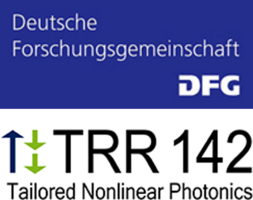Numerical Methods
We use and extend the Time Domain Discontinuous Galerkin method to perform the challenging multi-scale simulations in many of our projects.
Next topic: Plasmonics
Related publications by the TET group
Application of the Discontinuous Galerkin Time Domain Method in Nonlinear Nanoplasmonics
Y. Grynko, J. Förstner, in: 2018 IEEE 17th International Conference on Mathematical Methods in Electromagnetic Theory (MMET), IEEE, 2018.
Simulation of Second Harmonic Generation from Photonic Nanostructures Using the Discontinuous Galerkin Time Domain Method
Y. Grynko, J. Förstner, in: A. Agrawal (Ed.), Recent Trends in Computational Photonics, Springer International Publishing, Cham, 2017, pp. 261–284.
Hybrid coupled-mode modeling in 3D: perturbed and coupled channels, and waveguide crossings
M. Hammer, S. Alhaddad, J. Förstner, Journal of the Optical Society of America B 34 (2017) 613–624.
Guided Wave Interaction in Photonic Integrated Circuits — A Hybrid Analytical/Numerical Approach to Coupled Mode Theory
M. Hammer, in: A. Agrawal (Ed.), Recent Trends in Computational Photonics, 204th ed., Springer, 2017, pp. 77–105.
Wave interaction in photonic integrated circuits: Hybrid analytical / numerical coupled mode modeling
M. Hammer, in: J.-E. Broquin, G. Nunzi Conti (Eds.), Integrated Optics: Devices, Materials, and Technologies XX, SPIE, 2016, pp. 975018-975018–8.
Oblique incidence of semi-guided waves on rectangular slab waveguide discontinuities: A vectorial QUEP solver
M. Hammer, Optics Communications 338 (2014) 447–456.
Application of the discontinous Galerkin time domain method to the optics of metallic nanostructures
Y. Grynko, J. Förstner, T. Meier, AAPP | Atti Della Accademia Peloritana Dei Pericolanti 89 (2011).
Enhanced FDTD edge correction for nonlinear effects calculation
C. Classen, J. Förstner, T. Meier, R. Schuhmann, in: 2010 IEEE Antennas and Propagation Society International Symposium, IEEE, 2010.
Alle Publikationen anzeigen





